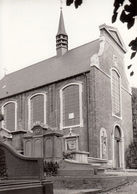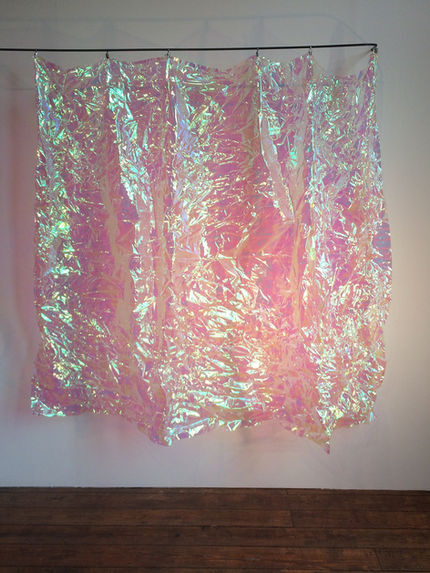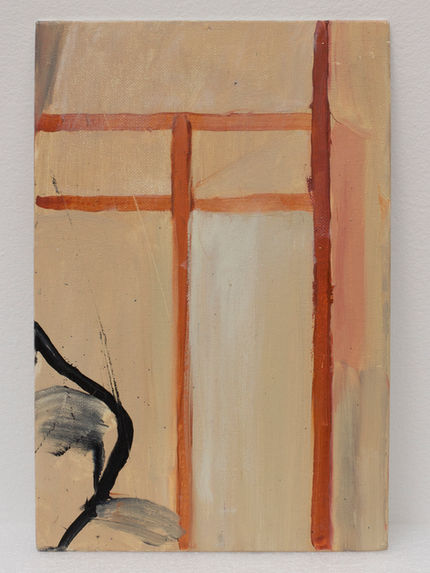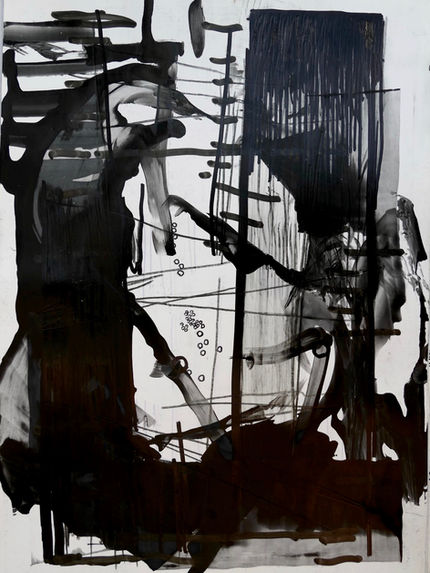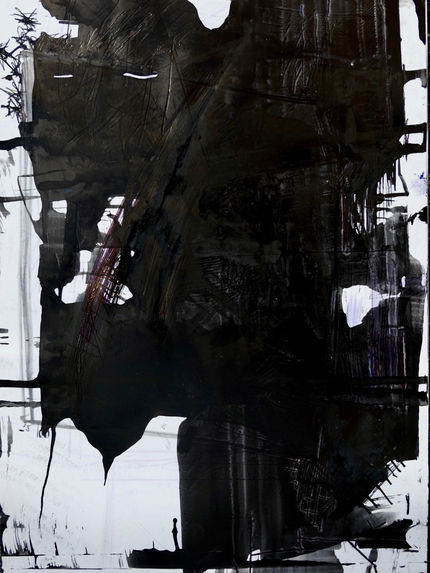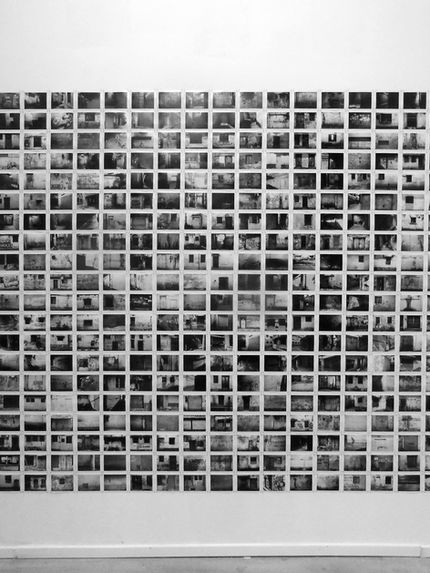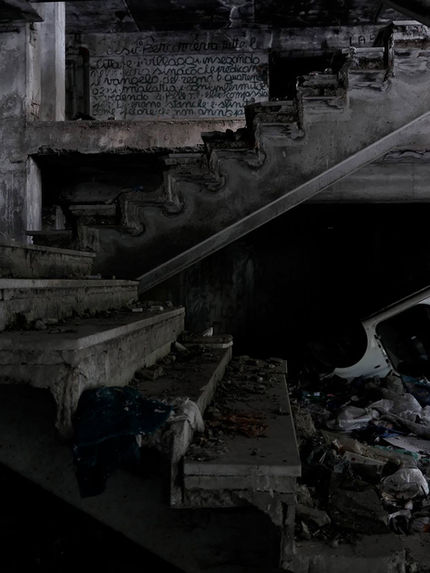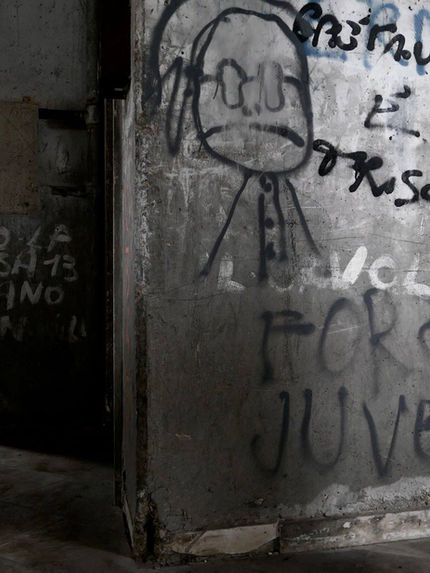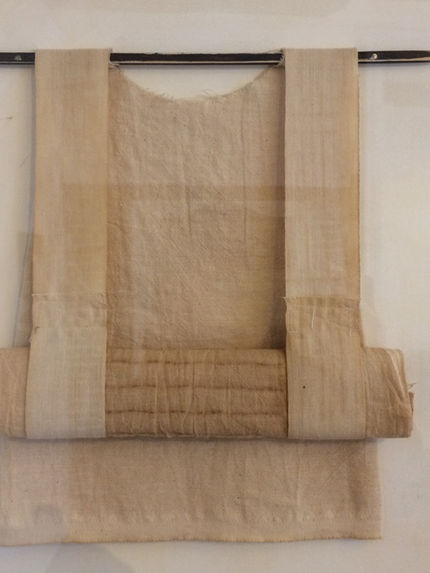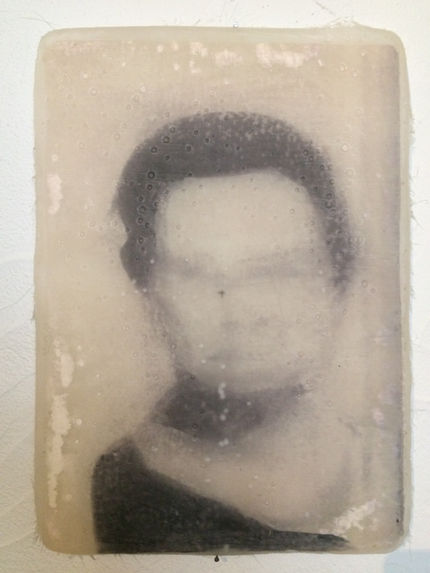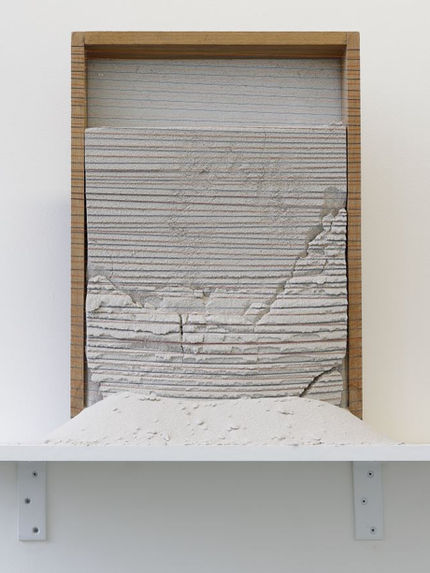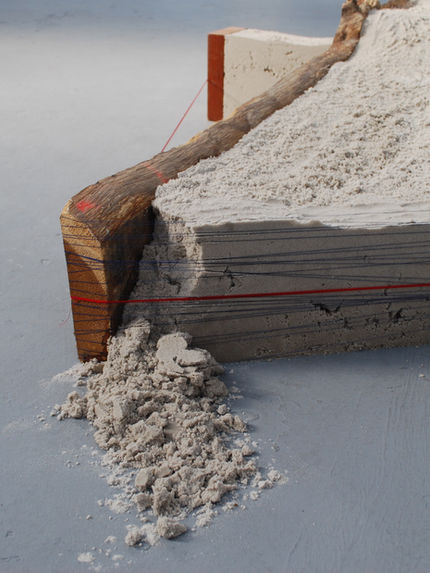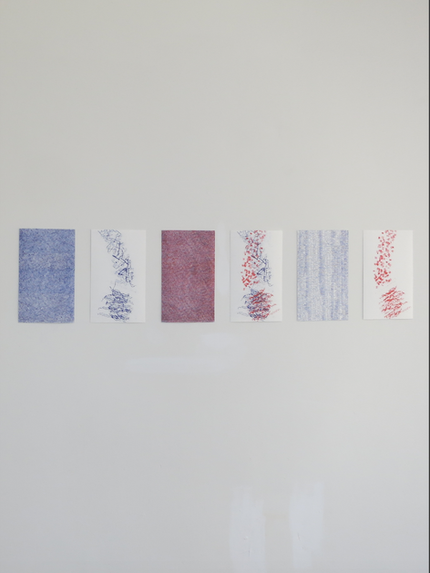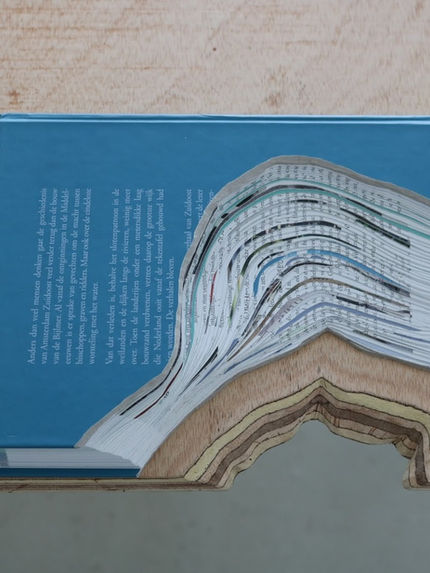
This exhibit revolves around art, especially painting, looked at through the concept of deconstruction. We want to analyse the materials that are the building blocks on which painting exists and has existed for centuries but also the concept of painting itself. What is it and how does it give or create meaning? How complex is the meaning painting generates and can we even be sure of it?
Since Derrida used the notion of deconstruction in the 1970’s it has influenced and dominated art and literature. This exhibit will focus on what form deconstruction has taken today and what it means for contemporary artists and art.

The Saint-Amanduskapel towers high above the monumental Campo Santo cemetery, which has a total of 131 graves.
The Chapel (built around 1480) was originally part of the monastery of the Alexian Brothers, where they, amongst others, took care of the ill and gave religious teachings. These monks were both beloved and detested throughout history, because they cared for plague victims and buried the dead, but they were also seen as a risk of infection.
The Chapel was destroyed in the Great Iconoclasm, but shortly after that the monks managed to reconstruct it. About 200 years later though, the French revolutionaries chased the monks away and took their teaching rights. The chapel then became in use as a military prison and later as a mental institution. After that, in 1863, it became again in the hands of teaching monks, who transformed the Chapel into a school and called it the St. Amandus Institute. Recently, it became property of the City of Ghent and, as such, an exhibition space.
Address: Verkortingstraat 11, 9040 Ghent, Belgium
Size: 128m2


ARTISTS
PROGRAM
PROGRAM
LUIS HERNÁNDEZ MELLIZO (COL)

Mateo Cohen (COL)
Mateo Cohen is a visual artist living and working in Berlin, Germany and Bogotá, Colombia. He studied at Los Andes University in Bogota and the university of the Arts in Berlin, where he received his master’s degree in the fine arts in 2012. He was a nominee for Nominee for the Residence scholarship „Junge Kunst in Essen and the „Meisterschülerpreis des Präsidenten“ of the University of the Arts Berlin in Berlin in 2012.
Mateo: "I paint images that seek to not put objects in front of the viewer's gaze. I clear out the surface of object-like painterly impressions in order to keep the image empty and to escape from any figure-background relationships. Thereby, the viewer enters through the surface of the painting into the image's space and comes out to the surface leaving the image behind. In other words: we experience (while moving with perception) the image as within a given surface (matter) and the surface as the construction of a given image (composition).
This attempt could be understood as a simple exercise of arranging the painting's building parts, that leads to nothing else but to painting itself. However, the resulting works seem not to be easily defined under this category. The use of frames, canvas and paint sets a context for my artistic practice and in the search of ways to relate these “materials” with one another, keeping borders, frames or definitions between means of image-making (drawing, sculpture, painting...) is no longer relevant.
For me, it seems more relevant to unfold the complexity of the surface and explore, through the act of painting, how space is concealed and disclosed by matter. In other words: how images come into being."

Charlie de Voet (BE)
Charlie de Voet lives in Zulzeke and works in Ronse. He also works part-time at Mark Manders' studio as Assistant Artist. He graduated with distinction in 2007 at The Royal Academy of Fine Arts (KASK) at Ghent. He received an Honourable Mention in the Grote Prijs Ernest Albert (2018) and received Third Prize at the Landscape Prize Michel Depyre (2016).
His paintings exist of many layers atop each other, from paper-thin to very thick. He describes it himself as a very labor-intensive act where the layers become more and more rough towards the end. The upper layer that arises carries traces of the used brushes, the drying process and the impact of outer forces (like gravity) on the skin of the painting. This “skin” is tactile and vulnerable, and seduces the viewer to study the work close-up and wanting to touch it, which is forbidden. Not being able/allowed to touch it and desiring to do that becomes part of the experience.
The fact that things aren’t always what they seem is also an apparent fascination of the artist. He likes to play with the technique of trompe l’oeil through placing a peephole, framework or a sphere into the painting as strange figures that disturb the illusion of flatness and replace it with a feeling of three-dimensionality.
“The art of Charlie De Voet shows the (in)capability of capturing the visual stimuli and mental images or views in one image, an alpha and omega, the all or nothing.” (Hans Martens)

Johan Gelper (BE)
Johan Gelper was born in Kapellen and lives and works in Ghent. He studied painting at Sint-Lucas in Ghent and also obtained his postgraduate degree at KASK. His work can be found in many public collections, amongst others those of the SMAK, Verbeke Foundation and the SONS Museum. He exhibits frequently in Belgium and Europe.
What distinguishes Johan Gelper’s work is his playful method of tracing. He tracks, discovers, draws, and accentuates a movement that seems to connect the immaterial world with the reality of tangible objects. The mental world of ideas and thoughts, which attract and repel, engage and disengage, open and close, take on surprising forms in Gelper’s work.
These forms are created by careful exploration, observation and sensing of the environment. His play on proportions colours the game of acceptance and avoidance. Found objects are combined to create a new situation. Connections are added with purifying precision, the artist always respecting the random nature of playful elements. His witty take on human attempts to make sense of the world, his tireless exploration of mediums and techniques, gives a lighthearted appearance to the work. Johan Gelper’s sense of aesthetics, which enables him to expose the true nature of objects, is especially admirable.
Gelper’s design makes fragments of our thoughts perceptible in space. A space that directs our thoughts and actions: front is connected to back, above is set in opposition to below, depth and surface complement each other, speed gives perspective to standing still, and so on.
The beauty of his work is not static, but is reflected in the dynamically vibrant balance between what creates human beings and what shapes and directs them.
Text by Lief Brijs (2016), translation by Kathy Kayser

Jonas Vansteenkiste (BE)
Jonas Vansteenkiste lives and works in Kortrijk. He obtained his master as well as his post-master in art & design at the KASK in Ghent. He particpated in many (inter)national exhibitions and received various (inter)national grants and residencies, amongst others the Rucka Artist Residency in Latvia (2020) and a residency at the ZK/U Center for Art and Urbanistics in Berlin (2016).
The works of the artist Jonas Vansteenkiste are defined by spaces. He uses several media, i.e. installations, video, sculpture, photos and drawings. He refers and uses – both in a physical and psychological way – architectural elements.
He builds up spaces, or creates situations which can best be defined as "mental spaces". Mental spaces have a resemblance with "Denkraum", a notion mostly found in philosophy and architecture. "Denkraum" can be seen as building walls, not only in but also from the chaos of one's own perception, emotions and thoughts to express in a clear way these experiences and feelings.
Keeping this in mind, Jonas defines and creates his works. These works depart from a personal experience where the anecdotal is moved
to the background where it is further purified into a "basso continuo" used to build upon. He approaches the medium "installation" as one of reference and experience. He thus places the spectator in an active role: he invites him to step into the work and situate himself – both mentally and physically – in it.
The artist also leaves room for the spectator to add his own personal experiences in these installations, which are not only the "relevant" place for the artist, but also for the spectator.
The same exercise is repeated in his drawings: these spaces are more personal so a spectator is only invited by a gaze…

Bernardo Montoya (COL)
Bernardo Montoya lives and works in Bogotá, where he founded and runs Salón Comunal, a space for contemporary art. He studied plastic arts (2006) and a Master in Art History and Theory of Modern and Contemporary Art (2009) in Los Andes University in Bogotá as well as Fine Arts at the Complutense University of Madrid (2004). He has exhibited internationally and curated many exhibitions. His work is part of the Art Collection of the Friends of Art Collections Foundation of the Banco de la República de Colombia-MAMU. He was selected to participate in the III Bogotá Plastic and Visual Arts Biennial Prize (2014) and received an honorable mention in the V Two-Dimensional Art Salon (Fundación Gilberto Alzate Avendaño, 2011).
He works with stratigraphies, layers of paint and formations of volumes from pictorial fluids. His works show paths that establish relationships between science and art and between natural objects and man-made objects.
Although Montoya became an artist in the form of a painter, he increasingly views this medium as an expanded discipline. He advocates a painting that escapes the frame: a painting that no longer depends on any support or restriction; but that depends only on itself. In its purest materiality, the painting reveals each of the overlapping layers throughout its production process up until the painting is formed. On its way it exposes decisions, errors and accidents, herewith raising the dialectic between the spontaneous and the natural.

Lorena Espitia (COL)
Lorena Espitia lives and works in Bogotá, Colombia. She has a BFA from the Academia Superior de Artes de Bogotá and an MFA from the California Institute of the Arts in Los Angeles, California. She exhibits frequently in Latin-America, the U.S. and Europe. She has participated in various residencies in Germany, Colombia and Mexico and has won many young art talent awards (a.o. Artecámara seccion 2018).
Lorena: “Often, my projects respond to specific circumstances that allow me to destabilize my own position as an artist by exploring heterogeneous representational strategies—those of advertising and graphic design, of the early Russian avant-gardes and popularized paleontological knowledge, of Godard's early films and vernacular science fiction—and by researching the possibilities of unfamiliar materials.”

Polien Boons (BE)
Polien Boons lives and works in Mechelen and graduated LUCA School of Arts in Brussels in 2014. She exhibits frequently in the Benelux and France and was the artist-in-residence at the STRT kit Antwerpen 2016- 2017.
Her works analyse and deconstruct the spatial realities that surround us, through the medium of collage. She was inspired in her way of perceiving the world by authors like Italo Calvino and Georges Perec, like in his work Espèces d'espaces (1974) in which he describes the space around himself in an very literal, objective way. Polien also uses this objective method in her collages and installations where she starts with deconstructing form by cutting abstract figures but then goes through the very human process of reconstruction, organising and recreating meaning. Her focus lies on the human necessity to make sense out of things, to organise and construct everything around us and the human failure to cope with the chaos surrounding us.
Colour also fascinates her, specifically structural colours that reflect light and never fade. These are to be found in nature on the wings of beetles and morpho-butterflies. She uses this motif in her work and would like to make some sort of paint out of these colours which would never fade and never have to be restored.

Barbara Rink (NL)
Barbara Rink lives and works in Amsterdam (NL). After receiving a BFA from the Royal Academy of Art at The Hague her work has been shown in The Netherlands as well as internationally. She has participated in various artist-residencies including URRA in Argentina, Santa Fe Art Institute (USA) and Vermont Studio Center (USA). Alongside her artistic practice Barbara Rink teaches film at Eye film museum. She is a recurring art tutor at the Minerva Academy of Art in Groningen and at the Artez School of Interior Design in Zwolle.
In her installation work Barbara uses the basic elements of painting as sculptural components. She dissects painting into enlarged cut out shapes, gradients, lines, shadow and light. These come together in fragile looking structures, mirroring constructions of the mind. By suggesting different moments in time happening at the same instant like falling apart and being under construction, she investigates organic and cyclical processes while adding a performative quality to the fixed works. Engaging with a perspective of magical thinking she considers the possibilities of painting and color as means of exploring three dimensional space.

Juan Rodríguez Varón (COL)
Juan R. Varon is a Colombian artist who lives and works in Belgium and Colombia. He was the 2016 artist-in-residence at the CAMAC Centre d’art Marnay Art Center in France. He exhibits frequently in Latin-America and elsewhere.
Juan: "At first, I'm triggered by situations I see in the world. I wonder about them, I’m curious about how they are: about the possibility of their precise visual configuration that couldn’t have come from my mind.
To me, painting is a place to respond to those situations since, through representation, it’s trying to understand them. But what is exciting about painting is to stumble in the process: in the path of mimesis, new unforeseen events occur on the surface. These new events (overlapping layers, clusters of pigment) arise tensions in relation to the canvas. I’m interested in the presence of painting, the tension it can convey, rather than its image.
If making art is giving an affirmation to the world, then the unforeseen, or the genuine character of the material, is a value I cherish to share."

Lieven Cateau (BE)
Lieven Cateau did not really have any training outside of ‘Advertising Design’ at Luca School Of Arts. He never really finished studies at other institutes but rather tasted them. Since the turn of the century, he has been active as a curator of larger art events and the driving force behind smaller art centers. He operates under the name ‘Strictly Rabbit’.
For years, Lieven Cateau has resided in gigantic world cities for certain moments of time. The work he has made since then arises from recurring, repetitive elements. During the working process, those ingredients are gradually destroyed by devising slopes. The lines of thought mean that spontaneous looking tracks are applied. The work is only finished when it radiates tranquility. The same tranquility that befalls the artist the moment he manages to fathom the rhythm of a certain city. It’s about ordering chaos.
The last series of works is inspired by the bus traffic in Lima. It deals with the situations that arise at overcrowded traffic points. A never-ending, thunderous steel carousel captured by an ever swelling mass of passengers. A never-before-invented dance choreography. You can also approach the works as music scores, in witch spheres represent percussion, lines for other instruments.
Text by Laura Morani

Laura Peña (COL)
Laura Peña is a Colombian artist who lives and works in Ghent. She has participated in and curated various exhibitions in Colombia, Argentina, Mexico and Belgium. She was the 2014 artist-in-residence for the La Mancha project invited by artist Luis Hernandez Mellizo and organized by La Paternal Espacio Proyecto LPEP in Buenos Aires, Argentina and she was selected for the #15 Regional Hall of the Colombian Cultural Ministry’s Curatorial Project and she was also selected for the #8 Young Art Hall (El Nogal, Bogotá). Laura is the founder of PARCE; an art initiative that resulted from connecting her own art with others. Her work has always been linked to identity, the search to find oneself but also the self in relation to others: Humans in relation to the humanity to which they belong. Therefore, the projects organized through Parce are a kind of unavoidable outcome of being connected with others and sharing in something beyond yourself. She consider individuals and ideas a product of collaboration (social and biological collaboration), beyond their own notions. Laura: "So I, Laura, don't necessary belong to myself but to a whole. We are the result of being a "social being", so collaboration becomes fundamental."
Laura: The work of Laura is essentially a search for identity, a search to the meaning of the portrait as a concept and a collective notion. What makes the portrait a portrait? By dissecting the elements of the possible identity of a physical space, Laura tries to find answers to that question.
"I think of my work as a process in layers. Instead of adding and subtracting layers of paint, I subtract dust (remains of an old construction for example) by way of scratching it off something (like a wall, a bed, a door...) during several days. This removing of dust becomes a dialogue and I find there is a similarity in the action of removing and the action of painting. Even when I create it into a sculpture, I feel that there is an inquiry to the portrait. The colour is particularly important, is the way I discover the story of what I am scratching similar to how you discover the story of a face when painting or photographing marks such as wrinkles. After scratching I also carefully select the colours so I can have different pigments to “stamp” what I have discovered. In this particular structure, I was thinking in terms of composition, colour and all the elements that a painting exists out off. It is a portrait that has no face but has time, information, nostalgia, and other elements from the subject I selected and from myself in relation to that self"

Sonja Geens (BE)
Sonja studied ‘Geaggregeerde voor het lager secundair onderwijs, beeldende vorming' at the Sint-Maria institute in Antwerp, after which she was a lecturer of visual education in the kdG-teacher training for 30 years. She now lives and works in Ghent, where she runs the Re-Mains gallery with her partner. In addition, they exhibit their work at numerous group exhibitions (including Watou 2019 City Festival) and other cultural projects. With their gallery Re-Mains they participate annually in the gallery event Ghent Soirees and in GANDA (Ghent Antiques Design Art).
She paints with acrylic paint and adapts skinny paint layers with water, sandpaper and resin. She also works with fragile materials such as beeswax, old paper, gauze and antique textiles.
She finds her inspiration in the small and in coincidence, from which she filters images of a shaky reality or of a place in the memory. Her work is sober, monochrome ,vulnerable and dubitable.

Gert van Dessel (BE)
Gert graduated with highest distinction in visual art at HONIM (Higher Education of Imelda) in Brussels. Gert lives and works in Ghent where he runs the Re-Mains gallery together with his partner. In addition, they exhibit their work at numerous group exhibitions (including Watou 2019 City Festival) and other cultural projects. With their gallery Re-Mains they participate annually in the gallery event Ghent Soirees and in GANDA (Ghent Antiques Design Art).
He works with synthetic resin and found objects. His nomadic search provides an archive of weathered materials. He manipulates the old findings and combines them with new materials through which he connects past and present. His traditional method of working and extensive material research gives unexpected textures and connections.

Emma van Roey (BE)
Emma van Roey is a Belgian artist working in Ghent and Maastricht. She finished her master in 2016 at LUCA School of Arts Ghent. She exhibits frequently in the Benelux and Switzerland. She was the 2019 artist-in-residence at the Jan van Eyck in Maastricht. She creates installations that ask to reflect on time through the vulnerable, tactile process of repetitive working with sand, wire and wood.
She creates installations that ask to reflect on time through the vulnerable, tactile process of repetitive working with sand, wire and wood. Her sculptures exist in the moment and seem to cling together in an almost poetic way, monumental in the space but fragile in the endlessness that surrounds it. In repeating what one could call “useless” acts, for her a way to get a grip over something elusive, she reminds us about the impossibilities of holding on to things.
“Emma’s images are attempts to wrap and hold what one cannot wrap and hold. Time intervenes yet during the making, but Emma goes on until that one intended image exists for a moment. Then she leaves it to time and decay. The lost image lays on the ground as loose sand, calling the viewer and raising questions.”

Luis Hernández Mellizo (COL)
Luis lives and works in Bogotá and Buenos Aires but frequently exhibits both individually and collectively in many different cities. He studied Visual Arts at the National University of Colombia in Bogotá (1996-2001 and 2008-2009) and at the National University of the Arts in Buenos Aires, Argentina (2012-2013 and 2016). He was a museum guide, member of El Bodegón (contemporary art-social life), workshop owner of Banco de la República in different Colombian cities and is coordinator of La Mancha, a project among artists to carry out temporary interventions in LPEP, an autonomous management in Buenos Aires.

Project direction by
LAURA PEÑA
in collaboration with
JOLIEN VERDOODT
The exhibition is based on the connections of people from different places. The project is organized on the basis of collaboration, from our own funds (by way of self-management) and the funds of the artists. We are trying to collect some recourses in order to assist some artists with covering part of their travel and transportation costs. If you want to support us, in general or for a specific project, please follow the link below to find out how.





























